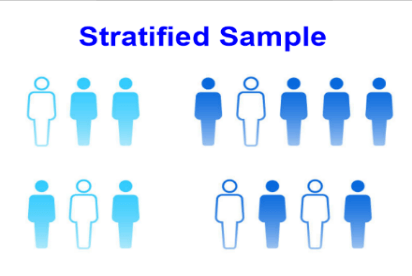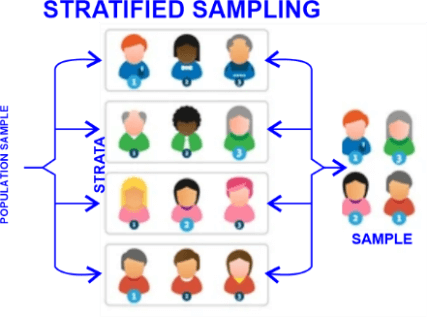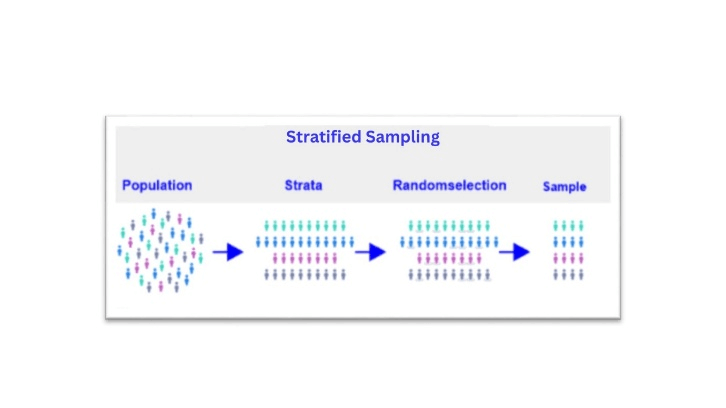Advantages and Disadvantages of Stratified SamplingStratified random sampling is the process of sampling where a population is first divided into subpopulations, and then random sample techniques are applied to each subpopulation. The inability of researchers to divide the population into subgroups is a drawback. 
Stratified sampling is unique and different from basic random sampling, which includes selecting data randomly from the overall population to ensure that each potential sample has an equal chance of occurring. Stratified random sampling, on the other hand, splits the population into different segments, or strata, based on shared traits. In direct proportion to the population size of each stratum relative to the population, a random sample is collected from each stratum. Here are some advantages and disadvantages of conducting stratified sampling. Advantages of stratified sampling1. Unbiased in natureWhen the provided population is divided into a number of homogenous groups according to purposive characteristics and then utilizing the technique of random selection to gather samples from each stratum, a well-prepared and performed stratified random sampling plan avoids the disadvantages of purposeful sampling and random sampling while still enjoying the benefits of both methods. Stratified random sampling ensures that each stratum or a significant portion of the population is adequately represented and removes the chance of any significant segment of the population being entirely neglected. In comparison to other sampling designs, stratified random sampling offers a more representative sample from the population and, as a result, produces less variability. 2. Higher accuracyCompared to regular random sampling, stratified random sampling offers more accurate estimates since the variability within each and every stratum is reduced. For example, in stratified random sampling, the sampling estimate of the population proportion is more effective than the similar estimate derived in simple random sampling in both proportional & Neyman's allocation of the sampling to distinct strata. 
3. Efficiency in survey executionStratified sampling can make data collecting easier and save survey expenses. The survey administrators often benefit when the entire population is divided into strata. When researchers divide a huge population into tiny groups with similar members, surveys can become less costly and more useful. These advantages arise when specialized persons, abilities, or areas of knowledge can survey a particular division more successfully. For example, you can employ several individuals to examine urban versus rural areas. The population's segmentation into comparatively homogeneous segments provides administrative ease as well. The stratified samples, as opposed to random samples, are anticipated to be regionally localized. The cost and time associated with data collection, respondent interviews, and fieldwork supervision are ultimately reduced as a result of this. 4. Reliable source for samplingFor various demographic groups, it is occasionally desirable to achieve distinct levels of accuracy. The only sampling strategy that permits us to obtain findings with known precision for each stratum is stratified random sampling. The sampling issues vary quite a bit in various population subgroups pretty frequently. When this occurs, the issue can be efficiently solved by stratified sampling by treating each component of the population as a separate stratum and addressing them separately during sampling. 
Disadvantages of stratified sampling1. Dependency on other factorsThe effective division of the population into homogeneous strata and the appropriate size of the sample to be obtained from each stratum are essential for stratified random sampling to be successful. The results will be affected if the stratification is flawed. Even using huge samples won't be able to make up for the mistake caused by incorrect stratification. A precise understanding of the size of the population in each stratum is necessary for the distribution of sample sizes among the various strata. Furthermore, stratified random sampling cannot be used effectively without knowing the variability or sample variance of each stratum, which is a severe constraint of Neyman's principle of optimum allocation. 2. Issue with value applicationThe values that must be applied to the various strata in a disproportional stratified sample must be accurate; otherwise, the samples will not be fair and may produce biased results. 3. Needs proper focusOnce the researchers are able to create subgroups that are reasonably homogeneous in comparison to the overall population can, stratified sampling yields benefits. The stratified sample won't be useful if researchers can't develop suitable strata or if the individuals within a stratum aren't substantially similar. |
 For Videos Join Our Youtube Channel: Join Now
For Videos Join Our Youtube Channel: Join Now
Feedback
- Send your Feedback to [email protected]
Help Others, Please Share









